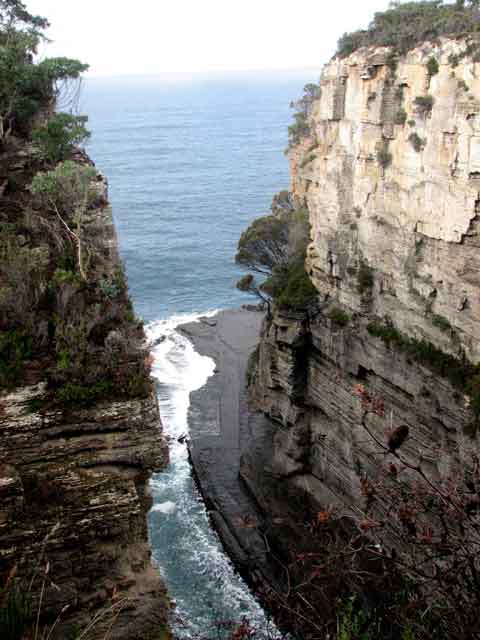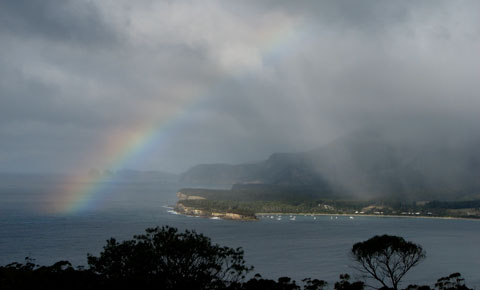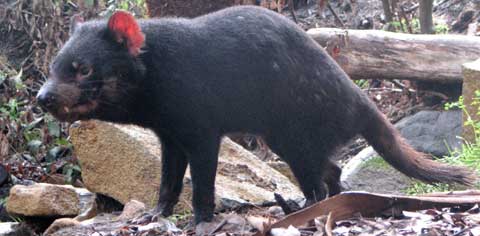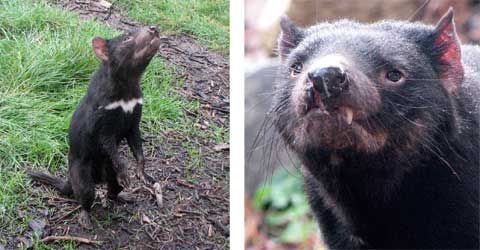 Near the bottom of the east coast of Tasmania is the Tasman Peninsula, a ragged blob of land reached via another, smaller blob, the Forestier Peninsula. They are a whisker of land away from being islands like Bruny, close to the coast — and to Hobart.
Near the bottom of the east coast of Tasmania is the Tasman Peninsula, a ragged blob of land reached via another, smaller blob, the Forestier Peninsula. They are a whisker of land away from being islands like Bruny, close to the coast — and to Hobart.
Having little time to find even a smudge of the wild Tasmania beyond the charming, hilly and human-sized Hobart, I headed down to the Tasman Peninsula for a few days’ camping.
 The coast around Eaglehawk Neck and beyond is rugged and stunning, but not totally wild, as outside the National Park, the accessible little bays in between the cliffs are dotted with small boats, and the shoreline with cottages, none of which can be called ‘shacks’ any more.
The coast around Eaglehawk Neck and beyond is rugged and stunning, but not totally wild, as outside the National Park, the accessible little bays in between the cliffs are dotted with small boats, and the shoreline with cottages, none of which can be called ‘shacks’ any more.
 But it is this narrow ‘neck’ , only 30 metres wide at its narrowest, that has helped make it a good place to try to hold the line against the spread of the facial tumours that are rapidly slashing the population of the Tasmanian Devil, the wild Tasmanian I am most keen to meet. Since 1996, the disease has killed 80% of them.
But it is this narrow ‘neck’ , only 30 metres wide at its narrowest, that has helped make it a good place to try to hold the line against the spread of the facial tumours that are rapidly slashing the population of the Tasmanian Devil, the wild Tasmanian I am most keen to meet. Since 1996, the disease has killed 80% of them.
At Taranna is the Tasmanian Devil Conservation Park, where I get my first real-life sight of the Devil, Australia’s largest surviving native carnivore, now the Tasmanian Tiger, the Thylacine, is extinct. It is also the world’s largest carnivorous marsupial.
I am shocked — he is so small. Heavier, but no bigger than a male Spotted-tail Quoll, as I see at home. And such an odd shape, as if his parts are mismatched, with that big head and blocky hindquarters. Such red ears! Such sharp teeth!
Around their hilly and holey natural living quarters they gallop about like rocking horses. At feeding time I ask the ranger about those those naked red ears; he says they are a means of communication– they get redder with excitement or anger.
They are inquisitive, standing upright and sniffing about, and their whiskers are extremely long. I am surprised to learn that every Devil has individual markings.
The ranger tosses chunks of fur-edged wallaby meat to the two females and one male in this area, where they squeal and growl and chase and fight each other for the best bits. Those teeth can chew through bone or nail or tough hide; they eat the lot, as the crunching we hear confirms. They quite fancy blood iceblocks in summer, he tells us.
Being scavengers, they have had an important role in cleaning up the astonishing amount of roadkill on Tasmanian roads. This has meant a lot get killed this way too — about 2000 each year — as if the cancers aren’t enough. The tumours are fatal within five months, and highly contagious, passed between the Devils by biting during mating and feeding.
 The Devils’ plight is tragic, and both State and Federal Governments ought to be pouring as much money into the research and protection programmes as these need. The Devils have no time for quibbling or bureaucracy.
The Devils’ plight is tragic, and both State and Federal Governments ought to be pouring as much money into the research and protection programmes as these need. The Devils have no time for quibbling or bureaucracy.
Saving the Devil from extinction is important, not just because they are iconic and unique, and it would be globally embarrassing if we lost it, but because they have a right to a continued existence, to their place in the ecological chain. While the origin of the tumours is unknown as yet, it is inconceivable that we humans have not had role in their demise.
Hi Denis, I don’t know about that; could probably ask on that Devil web site.
Hi Sharyn
Good posting, with the links to the Devils pages.
Its hard to see that they can save them completely. Probably a few in zoos may survive.
The map shows none with infection on the north-west and west, but are there Devils over that side?
It is very sad.
Denis